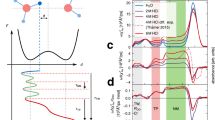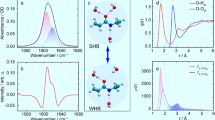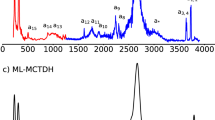Abstract
Given the critical role of the aqueous excess proton in redox chemistry, determining its structure and the mechanism of its transport in water are intense areas of experimental and theoretical research. The ultrafast dynamics of the proton’s hydration structure has made it extremely challenging to study experimentally. Using ultrafast broadband two-dimensional infrared spectroscopy, we show that the vibrational spectrum of the aqueous proton is fully consistent with a protonated water complex broadly defined as a Zundel-like H5O2+ motif. Analysis of the inhomogeneously broadened proton stretch two-dimensional lineshape indicates an intrinsically asymmetric, low-barrier O–H+–O potential that exhibits surprisingly persistent distributions in both its asymmetry and O–O distance. This structural characterization has direct implications for the extent of delocalization exhibited by a proton’s excess charge and for the possible mechanisms of proton transport in water.
This is a preview of subscription content, access via your institution
Access options
Access Nature and 54 other Nature Portfolio journals
Get Nature+, our best-value online-access subscription
$29.99 / 30 days
cancel any time
Subscribe to this journal
Receive 12 print issues and online access
$259.00 per year
only $21.58 per issue
Buy this article
- Purchase on Springer Link
- Instant access to full article PDF
Prices may be subject to local taxes which are calculated during checkout





Similar content being viewed by others
References
Agmon, N. The Grotthuss mechanism. Chem. Phys. Lett. 244, 456–462 (1995).
Marx, D. Proton transfer 200 years after von Grotthuss: insights from ab initio simulations. ChemPhysChem 7, 1848–1870 (2006).
Cukierman, S. Et tu, Grotthuss! And other unfinished stories. Biochim. Biophys. Acta Bioenerg. 1757, 876–885 (2006).
Agmon, N. et al. Protons and hydroxide ions in aqueous systems. Chem. Rev. 116, 7642–7672 (2016).
Zundel, G. & Metzger, H. Energiebänder der tunnelnden Überschuß-Protenon in flüssigen Säuren. Eine IR-spektroskopische Untersuchung der Natur der Gruppierungen H5O2 +. Z. Phys. Chem. 58, 225–245 (1968).
Janoschek, R., Weidemann, E. G., Pfeiffer, H. & Zundel, G. Extremely high polarizability of hydrogen bonds. J. Am. Chem. Soc. 94, 2387–2396 (1972).
Janosche., R., Weidemen, E. G. & Zundel, G. Calculated frequencies and intensities associated with coupling of proton motion with hydrogen-bond stretching vibration in a double minimum potential surface. J. Chem. Soc. Faraday Trans. II 69, 505–520 (1973).
Wicke, E., Eigen, M. & Ackerman, T. Über den zustand des protons (hydroniumions) in wäßriger lösung. Z. Phys. Chem. 1, 340–364 (1954).
Eigen, M. & Maeyer, L. D. Self-dissociation and protonic charge transport in water and ice. Proc. R. Soc. Lond. 247, 505–533 (1958).
Thämer, M., De Marco, L., Ramasesha, K., Mandal, A. & Tokmakoff, A. Ultrafast 2D IR spectroscopy of the excess proton in liquid water. Science 350, 78–82 (2015).
Dahms, F. et al. The hydrated excess proton in the Zundel cation H5O2 +: the role of ultrafast solvent fluctuations. Angew. Chem. Int. Ed. 55, 10600–10605 (2016).
Dahms, F., Fingerhut, B. P., Nibbering, E. T. J., Pines, E. & Elsaesser, T. Large-amplitude transfer motion of hydrated excess protons mapped by ultrafast 2D IR spectroscopy. Science 357, 491–495 (2017).
Daly, C. A. et al. Decomposition of the experimental Raman and infrared spectra of acidic water into proton, special pair, and counter-ion contributions. J. Phys. Chem. Lett. 8, 5246–5252 (2017).
Carpenter, W. B., Fournier, J. A., Lewis, N. H. C. & Tokmakoff, A. Picosecond proton transfer kinetics in water revealed with ultrafast IR spectroscopy. J. Phys. Chem. B 122, 2792–2802 (2018).
Biswas, R., Carpenter, W., Fournier, J. A., Voth, G. A. & Tokmakoff, A. IR spectral assignments for the hydrated excess proton in liquid water. J. Chem. Phys. 146, 11 (2017).
Berkelbach, T. C., Lee, H. S. & Tuckerman, M. E. Concerted hydrogen-bond dynamics in the transport mechanism of the hydrated proton: a first-principles molecular dynamics study. Phys. Rev. Lett. 103, 238302 (2009).
Marx, D., Tuckerman, M. E., Hutter, J. & Parrinello, M. The nature of the hydrated excess proton in water. Nature 397, 601–604 (1999).
Kulig, W. & Agmon, N. A. ‘Clusters-in-liquid’ method for calculating infrared spectra identifies the proton-transfer mode in acidic aqueous solutions. Nat. Chem. 5, 29–35 (2013).
Giberti, F., Hassanali, A. A., Ceriotti, M. & Parrinello, M. The role of quantum effects on structural and electronic fluctuations in neat and charged water. J. Phys. Chem. B 118, 13226–13235 (2014).
Swanson, J. M. J. & Simons, J. Role of charge transfer in the structure and dynamics of the hydrated proton. J. Phys. Chem. B 113, 5149–5161 (2009).
Asmis, K. R. et al. Gas-phase infrared spectrum of the protonated water dimer. Science 299, 1375–1377 (2003).
Headrick, J. M. et al. Spectral signatures of hydrated proton vibrations in water clusters. Science 308, 1765–1769 (2005).
Fournier, J. A. et al. Snapshots of proton accommodation at a microscopic water surface: understanding the vibrational spectral signatures of the charge defect in cryogenically cooled H+(H2O)n=2-28 clusters. J. Phys. Chem. A 119, 9425–9440 (2015).
Heine, N. et al. Isomer-selective detection of hydrogen-bond vibrations in the protonated water hexamer. J. Am. Chem. Soc. 135, 8266–8273 (2013).
Kim, J., Schmitt, U. W., Gruetzmacher, J. A., Voth, G. A. & Scherer, N. E. The vibrational spectrum of the hydrated proton: comparison of experiment, simulation, and normal mode analysis. J. Chem. Phys. 116, 737–746 (2002).
Xu, J. Q., Zhang, Y. & Voth, G. A. Infrared spectrum of the hydrated proton in water. J. Phys. Chem. Lett. 2, 81–86 (2011).
Knight, C. & Voth, G. A. The curious case of the hydrated proton. Acc. Chem. Res. 45, 101–109 (2012).
Vendrell, O., Gatti, F. & Meyer, H.-D. Full dimensional (15-dimensional) quantum-dynamical simulation of the protonated water dimer. II. Infrared spectrum and vibrational dynamics. J. Chem. Phys. 127, 184303 (2007).
Wolke, C. T. et al. Spectroscopic snapshots of the proton-transfer mechanism in water. Science 354, 1131–1135 (2016).
Guasco, T. L., Johnson, M. A. & McCoy, A. B. Unraveling anharmonic effects in the vibrational predissociation spectra of H5O2 + and its deuterated analogues. J. Phys. Chem. A 115, 5847–5858 (2011).
Yu, Q. & Bowman, J. M. Communication: VSCF/VCI vibrational spectroscopy of H7O3 + and H9O4 + using high-level, many-body potential energy surfaces and dipole moment surfaces. J. Chem. Phys. 146, 121102 (2017).
Biswas, R., Carpenter, W., Voth, G. A. & Tokmakoff, A. Molecular modeling and assignment of IR spectra of the hydrated excess proton in isotopically dilute water. J. Chem. Phys. 145, 12 (2016).
Stoyanov, E. S., Stoyanova, I. V. & Reed, C. A. The unique nature of H+ in water. Chem. Sci. 2, 462–472 (2011).
Carpenter, W. B., Fournier, J. A., Biswas, R., Voth, G. A. & Tokmakoff, A. Delocalization and stretch–bend mixing of the HOH bend in liquid water. J. Chem. Phys. 147, 084503 (2017).
Petersen, P. B. & Tokmakoff, A. Source for ultrafast continuum infrared and terahertz radiation. Opt. Lett. 35, 1962–1964 (2010).
Acknowledgements
This work was supported by the Office of Basic Energy Sciences, US Department of Energy under grant DOE DE-SC0014305. J.A.F. thanks the Arnold O. Beckman Foundation for support through a postdoctoral fellowship. N.H.C.L. acknowledges support from the Yen Fellowship programme.
Author information
Authors and Affiliations
Contributions
J.A.F. and A.T. conceived and designed experiments. J.A.F., W.B.C. and N.H.C.L. performed the experiments. All authors discussed the results, analyses and interpretations. J.A.F. and A.T. wrote the paper with input from all authors.
Corresponding author
Ethics declarations
Competing interests
The authors declare no competing interests.
Additional information
Publisher’s note: Springer Nature remains neutral with regard to jurisdictional claims in published maps and institutional affiliations.
Supplementary information
Supplementary information
Supplementary Data and Analysis, Supplementary Figures 1–14
Rights and permissions
About this article
Cite this article
Fournier, J.A., Carpenter, W.B., Lewis, N.H.C. et al. Broadband 2D IR spectroscopy reveals dominant asymmetric H5O2+ proton hydration structures in acid solutions. Nature Chem 10, 932–937 (2018). https://doi.org/10.1038/s41557-018-0091-y
Received:
Accepted:
Published:
Issue Date:
DOI: https://doi.org/10.1038/s41557-018-0091-y
This article is cited by
-
Thermal dependence of the hydrated proton and optimal proton transfer in the protonated water hexamer
Nature Communications (2023)
-
Vibrational signature of hydrated protons confined in MXene interlayers
Nature Communications (2023)
-
Spectral signatures of excess-proton waiting and transfer-path dynamics in aqueous hydrochloric acid solutions
Nature Communications (2022)
-
The coupling of the hydrated proton to its first solvation shell
Nature Communications (2022)
-
Identifying Eigen-like hydrated protons at negatively charged interfaces
Nature Communications (2020)



